For as long as I can remember, I have had debilitating gastrointestinal issues, including IBS, Gastritis and GERD (Gastroesophageal Reflux Disease). Although these are common stomach and gastro diseases, I have had extreme symptoms including violent vomiting, coughing up blood, stomach ulcers, and even tears in my stomach, which as you can imagine has been painful. While I take care of myself using mindful self-care tips, it can be all too frustrating that despite my best efforts, I am sick most days. To an average person I look healthy, and while I could be a lot worse, my stomach condition has an impact on my day-to-day life. I am sensitive to oily, fatty, creamy, spicy, and acidic foods, and get symptoms such as bloating, cramping, nausea, and dizziness on a day-to-day basis. At times I was frustrated. After all, I had made huge overhauls to my diet, and lifestyle, and was eating better, and exercising more than ever before. So, what was going wrong? Well, there were foods I was eating, that I was highly sensitive to. I just didn’t know it yet, but thanks to Health Hub and their food intolerance test, I would soon…

As someone who keeps a food diary, I liked to think that I was aware of what was making me sick. I knew I had allergies to mushroom, aubergine, courgette, and caffeine, and was pretty sure I had sensitivities too. I would often vomit after eating food such as tomatoes (too acidic), drinking orange juice (also acidic), food heavy in cream (like vegan Carbonara’s), and anything that was ‘fast food’ (like vegan burgers), and some days would be better than others. Despite the food diary, there were no identifiable patterns in addressing triggers, and symptoms, as one day I could have food, and the next day, the exact same recipe would make me horribly, and violently sick. Although I had a mental health toolkit to help me during the days where I was at my sickest, at times I felt embarrassed when people would stare at me, as I was sick in public. Thinking I was drunk, they would tut not so subtly under their breath, looking at me in disgust. If only they knew the invisible illnesses that I had. I was thankful that I could manage my illness, but at the same time I craved respite.
Despite being a healthy vegetarian, I was flummoxed that I hadn’t been able to heal myself through my diet. It wasn’t just the bloating, nausea, and sickness, but it was also the brain fog, joint pain, and overwhelming fatigue that made day to day tasks a struggle to get through. I was struggling to identify which parts of my diet, were causing my sickness, especially when I was so careful to avoid my known allergies, and triggers that I knew made me sick. On days where I was feeling at my worst, I would opt for plain foods, and on days where my stomach felt good, I was cautious, but ate more adventurously. I thought I was in tune with what my body needed, but something was still amiss. Which is when I came across Health Hub, whose goal was to make healthcare accessible to all.

I have made significant changes to my diet and lifestyle before working with Health Hub. However I had food sensititivities that I wanted to address.
From food intolerance tests to allergy tests, thyroid function tests, and even PCR tests, this online platform was incredibly convenient for someone like me. Choosing a food intolerance test seemed like the obvious choice, as I wanted to know whether there were food sensitivities that I had no idea I had. Turns out, I had quite a few unknown food intolerances! But what is a food intolerance?
What Is A Food Intolerance?

I knew what allergies I had, but I wasn’t aware of my food intolerances. Health Hub showed me my results.
Unlike allergies, intolerances are not life threatening. A food intolerance is difficulty digesting certain foods, and having an unpleasant physical, and even emotional reaction to them. Whether this is vomiting, stomach cramps, bloating, or acid reflux, these food sensitivities are uncomfortable to deal with. The three most common food intolerances are lactose, a sugar found in milk, casein, a protein found in milk, and gluten, a protein found in grains such as wheat, rye, and barley.
For me, I know that I have food allergies to mushroom, aubergine, courgette, and caffeine. I am also allergic to penicillin, which is a bit unfortunate. Unlike my food sensitivities, if I eat or drink one of these foods, I get a bad allergic reaction, and usually end up in hospital. Although I am very careful to check ingredients, especially when I am eating out, I have had a bad allergic reaction, as recently as two years ago, where I unknowingly ingested mushroom, in a food’s sauce, despite making them aware of my existing allergies. As a result, I had to be taken to the hospital, as I had hives, nausea, excessive vomiting, and shortness of breath. They later found other health issues, which made my hospital stay a lucky visit in the end, but it was proof to me of the difference between allergies and intolerances.

A food allergy is an immune system response, whereas an intolerance is a digestive system response. Having an intolerance (such as my sensitivity to acidic foods), means that you are unable to properly digest, or break down the food. Unlike allergies though, sometimes you need a large quantity of the food you are sensitive to, to have a reaction, although this is not true in my case.My stomach is overly sensitive, so even a small amount of triggering food, can make me sick. So, knowing that I could take a food intolerance test, was going to be extremely useful for me. While I was being kind to myself, and eating better, it was hard to know what to cook, when I seemed to be triggered by so many foods. With Health Hub, I was able to take an easy, peasy test, with simple instructions that allowed me to test for my food sensitivities.
Should You Take A Food Intolerance Test?

Partnering with Health Hub was an eye opening experience. I had intolerances that I did not know I had.
If like me, you have noticed that certain foods are triggering you, it would be worth taking a food intolerance test? Why? Well asides from giving you peace of mind, it can also help you tailor your diet, by identifying which foods are affecting your digestive system. Unlike an elimination diet, that cuts out foods, is difficult to follow, and takes time to test symptoms, your food intolerance test can immediately pinpoint which foods to avoid.
How Does A Food Intolerance Test Work?
Health Hub’s food intolerance test, measures the concentration of specific IgG4 intolerances in your blood to 80 different foods, using a finger prick blood sample. The food intolerance test covers meat, fish, gluten containing grains, dairy and egg, fruit, vegetable, herbs, and salad, legumes, and nuts and seeds. Although IgG4 antibody testing for food intolerance does not test for coeliac disease, lactose intolerance, histamine intolerance or IgE food allergy, it does give you a comprehensive view of what sensitivities you have.
So how do you take a test?
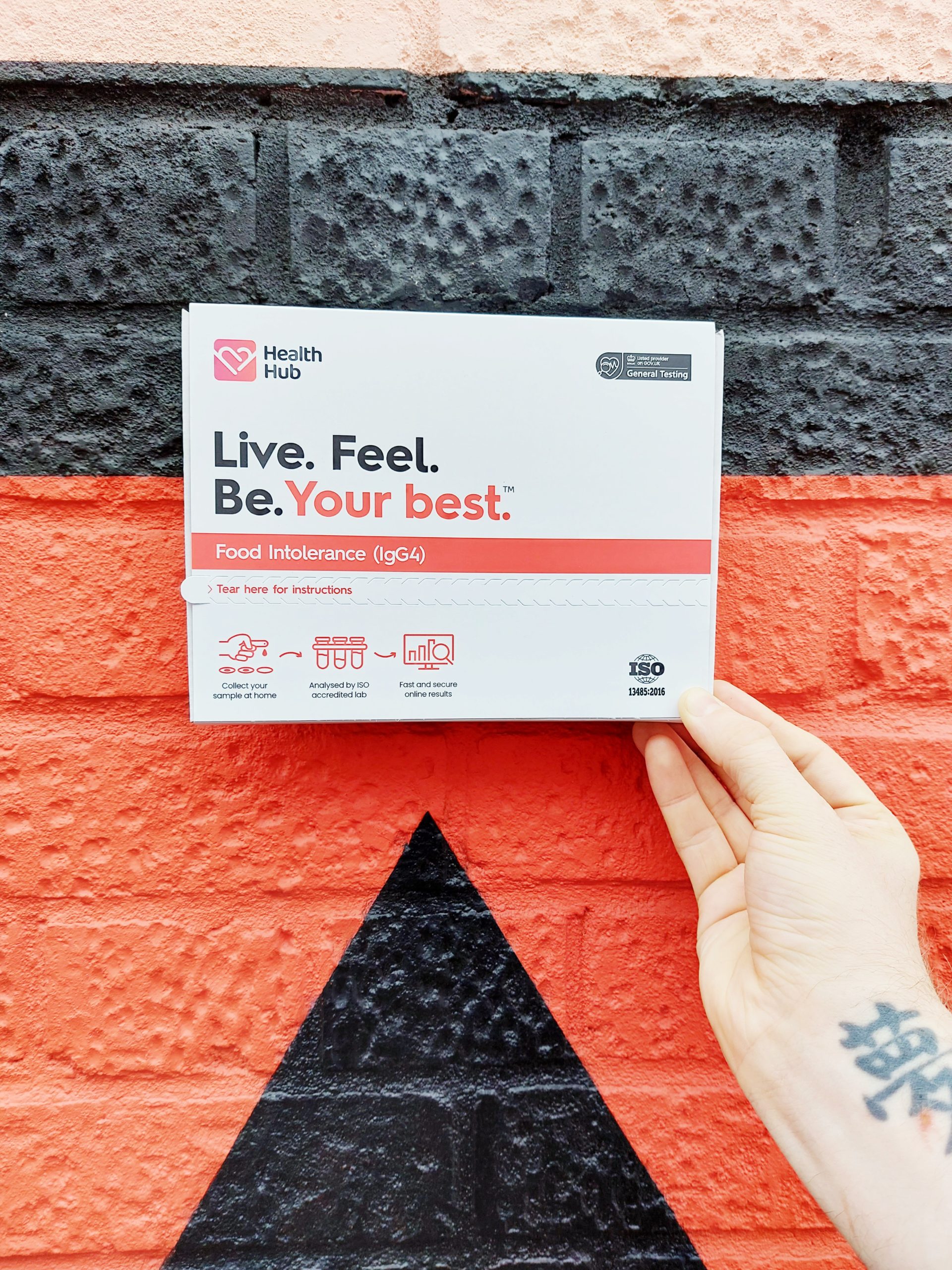
This is what the packaging of the Health Hub blood test looks like.
First things first…
- Select your test. Your test will be delivered to your door and comes with easy-to-follow instructions on how to take your test.
- Once your test has arrived activate your test online before you return your sample, as otherwise your test won’t be valid. Also drink 2 glasses of water, 30 minutes before you take your test, as being hydrated will help your blood flow better.
- Please remember to take your blood test between Monday to Thursday and return your sample on the same day that you do it.
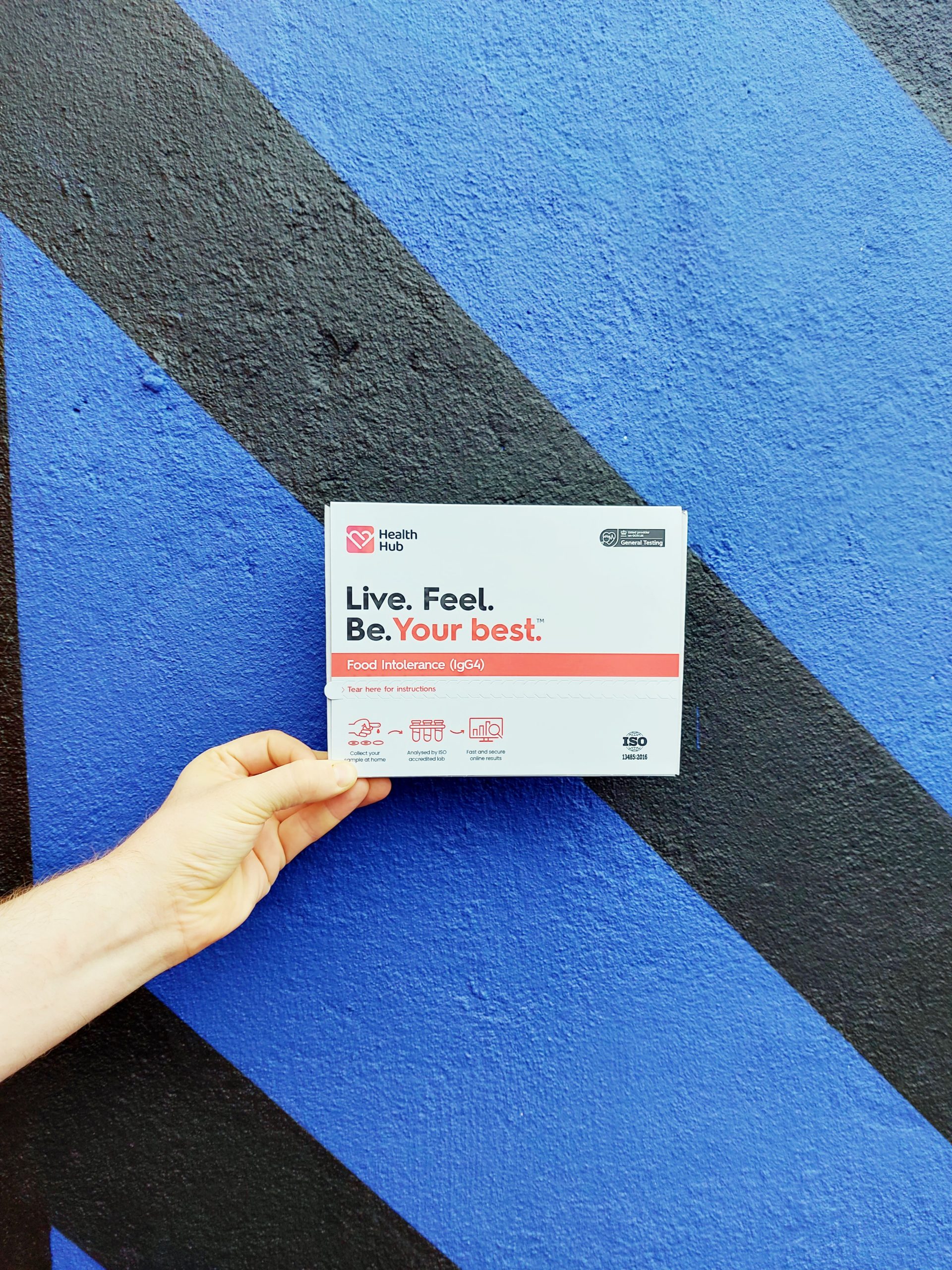
How To Take Your Blood Test
- Wash your hands thoroughly before taking a sample. Rotate the arm you will take the test from, in a circular motion. If you are going to prick your left finger, then rotate that arm.
- Disinfect your index, or middle finger with the alcohol wipe provided, and wait 15 seconds for it to arrive.
- Remove the blood spot card from the plastic bag (do not touch the filter paper in the middle).
- Hold the single use lancet horizontally, rotate the protective cover, and remove.
- Hold the Lancet against the tip of your selected finger, and firmly press the button with your thumb.
- While standing up massage the punctured finger to form a drop of blood.
- Allow the drops of blood to drip on the specified circles on the blood spot card.
- Do not touch the card with your finger. Allow 5 minutes for the sample to dry. There is a plaster provided for your finger.
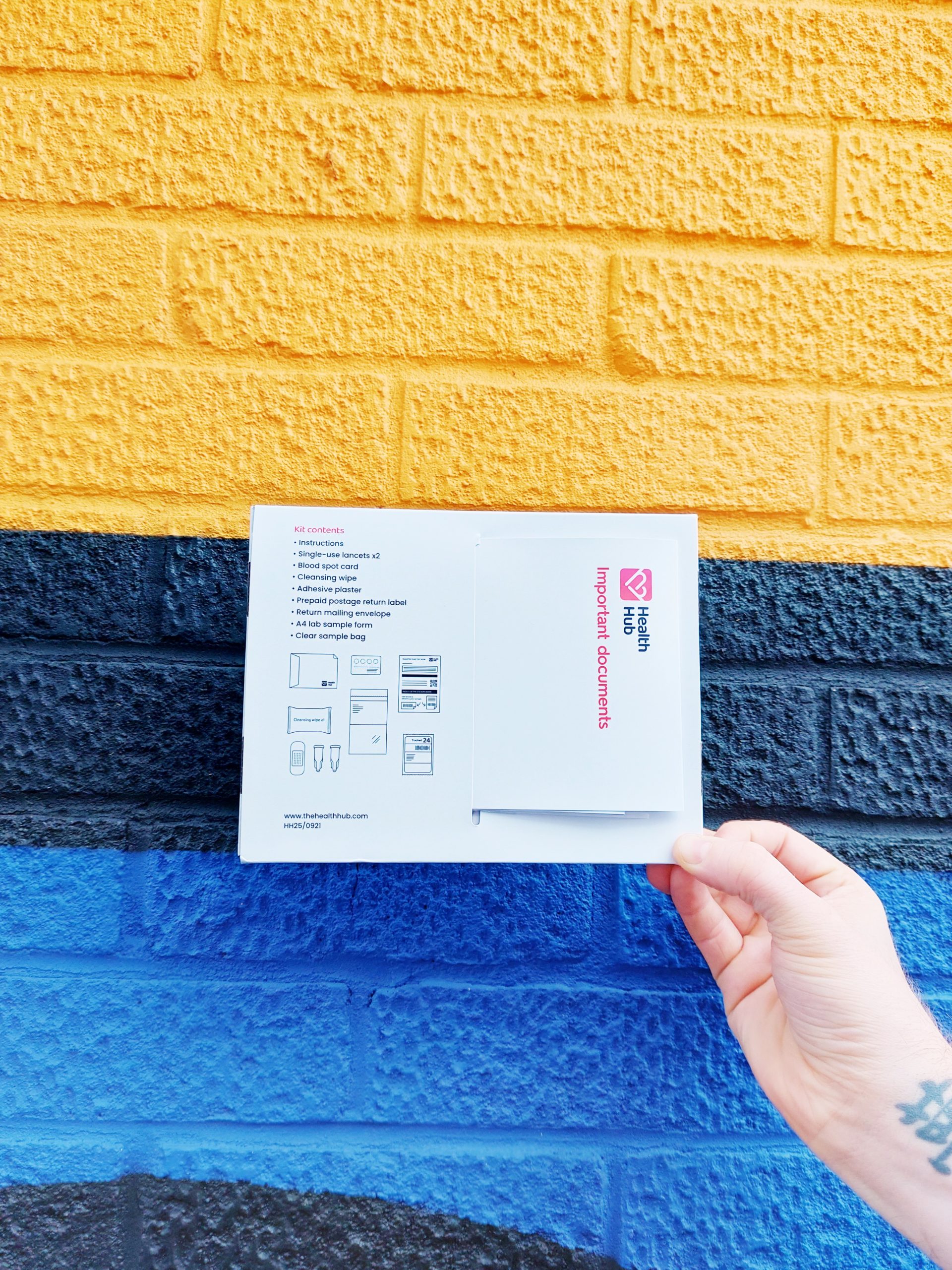
How To Label Your Blood Sample
- Carefully complete the details on your lab sample form.
- Now apply the small barcode sticker ‘A’ to the reverse of your blood spot card.
- Place the blood spot card into the sample bag provided.
- Apply the larger sticker B to the outside of the sample bag.
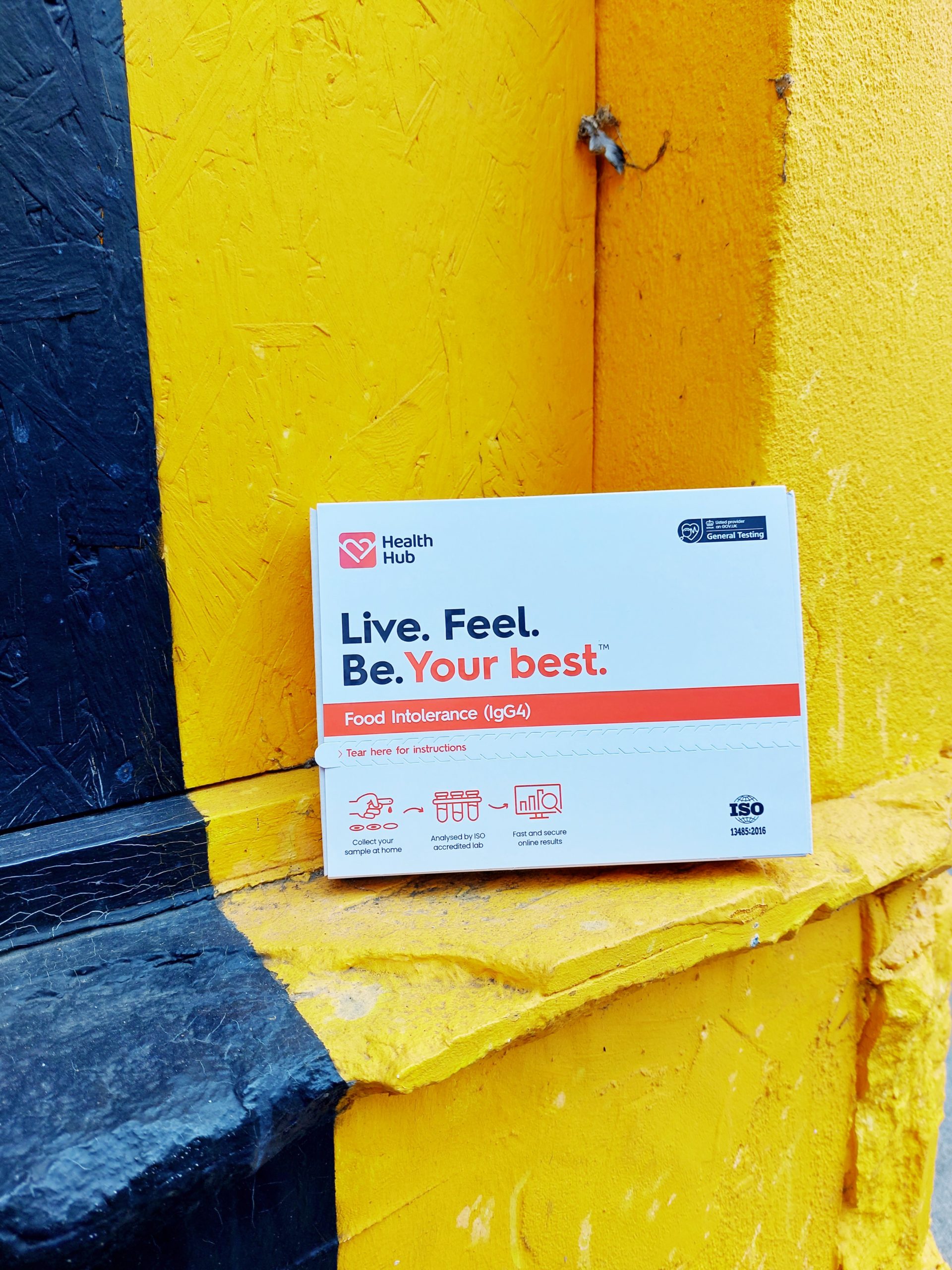
How To Post Your Sample
- Insert your bagged sample into the self-seal envelope provided.
- Apply the postage paid shipping label, to the return envelope.
- Return your sample Monday-Thursday and check your post-box times. The lab is not open at the weekends.
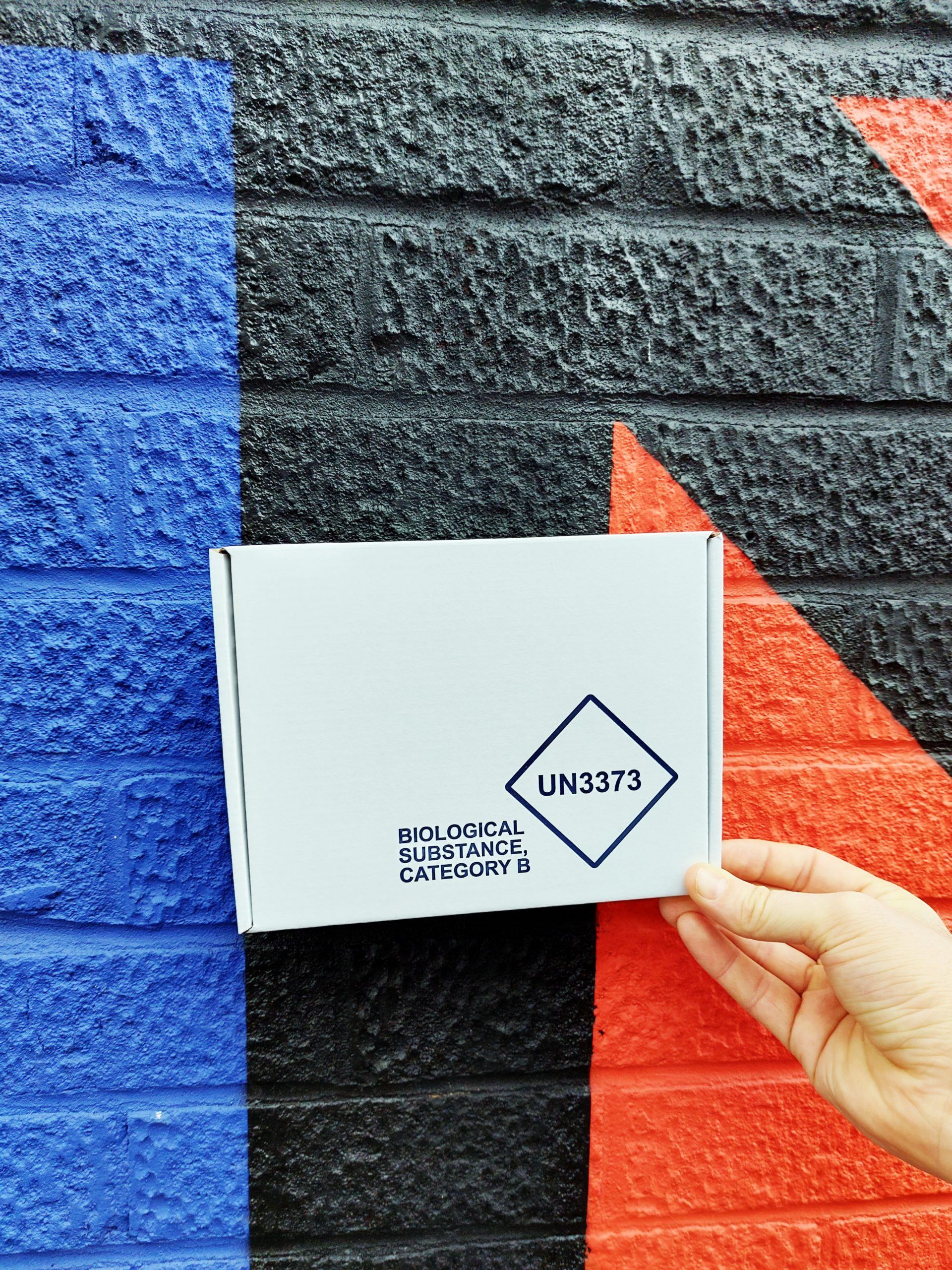
What Happens Next?
As to how long your results take, is dependent on how quickly the lab gets your result. Occasionally there can be issues with Royal mail, delaying the sample from reaching the lab. For me, I needed to order a second test, as there was an issue with the first test. While I had to wait a while to receive my results, there is normally a very quick turnaround.Usually what happens is you receive a text, and email when your test result is ready. Your results will be available via the Health Hub website, where you can see all your intolerances in one place, and even download them as a handy PDF. Your intolerances are split into green, yellow, amber, and red and can also be found under categories like legumes, vegetables, and meat.
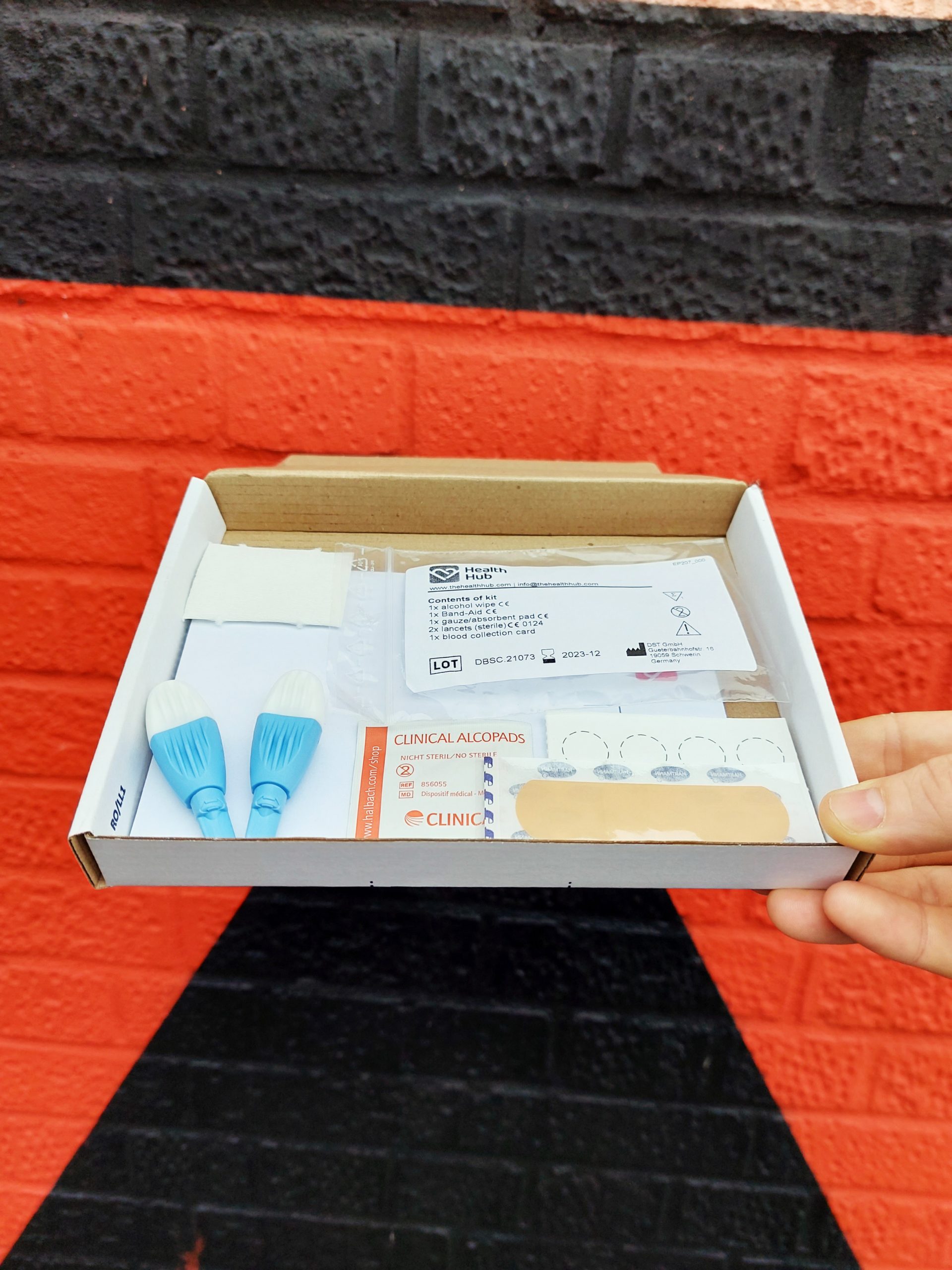
I didn’t think that taking a food intolerance test at home would be easy. But Health Hub has very detailed instructions that are clear to follow.
I found having a breakdown of my intolerances very helpful, as it showed me exactly what foods I should be moderating, and which foods I should be eating more of. Not only this, but Health Hub had a handy resources section, which showed me substitutes I could use for my intolerances, as well as a reintroduction diary, which I will go into more detail about later. Unlike having your tests sent to you via post, having them via an online platform, means that you can clearly see your results, at a click of a button. It is easy, as 1,23.
My Results And What It Showed Me
Bearing in mind I had to wait a while for the results, I was curious to see what intolerances I had. I presumed that I knew my intolerances, but it turns out that I was wrong in some cases and baffled in others. It was an eye-opening experience to say the least and made me revaluate the way I was looking at food, from consumption, to shopping. There were a few intolerances, that I had expected, but most of them surprised me tenfold.

High Food Intolerances (Red)
In the red section, where a high IgG4 reaction had taken place, I had 11 intolerances, which Health Hub recommended I eliminated for 2 months. These included green beans, soy, sweet basil, as well as meats and fish (which I don’t eat as a vegetarian) including beef, duck, and salmon. Now this was the interesting part, having so many meat and fish intolerances in the red section, made sense. After all, I hadn’t eaten meat in over 10 years, so naturally this would be something that my body would be sensitive to.
The soy, green beans, and basil was surprising to me, although made sense. Soy was in some vegan substitutes that I eat, as well as tofu, tempeh, protein bars, soy milk and edamame. While I didn’t eat soy in huge quantities, looking back I noticed I would have a reaction such as gastrointestinal discomfort, a ‘funny stomach’ and in some cases disrupted bowel movements. Because I don’t eat a lot of soy, it wasn’t something I had picked up on before, but it made sense.

Green beans on the other hand, and basil I ate a lot of. I ate a lot of green vegetables like kale, broccoli, and green beans, and would often get gas, and a bloated stomach. I attributed this as being normal, given that green vegetables contain complex sugars like raffinose, which creates excess gas. With basil, again, as I ate it as a garnish, I often would blame the tomatoes for giving me a dodgy stomach, when it might have been the other way round. I thought it was quite mild, although as a pesto, I found it hard to digest, as it was too rich for my stomach. So maybe it was about how I was preparing the basil.
Millet was another vegetarian food that I had a high reaction to, and I was confused as I believed I did not eat it. However, when I found out it was an ingredient in flatbreads, beer, and fermented beverages it made sense. As much as I liked beer, I could only have it in small quantities, because I would get cramps, and bloating if I drank too much. It felt ‘heavy on my stomach’, so this result was self-explanatory.
Medium Food Intolerances (Amber)
In the Amber section, where a medium reaction had taken place, it was again a mixed bag. Some results I was surprised by, and others were what I had expected. Health Hub’s result system advised me to limit these 18 further intolerances for a month, or greatly reducing consumption. These included barley, buckwheat, lentils, mango, green peas, pumpkin seeds, rye, and zucchini, as well as assorted fish, and meat such as chicken and pork.

Zucchini made sense, after all I am allergic to courgette, although my mushroom, and caffeine allergy is worse. I haven’t eaten it since I was 17/18, so of course it will show up as a high reaction to this food. With chicken, pork, and blue mussels, this again was evidently because I haven’t had meat or fish, for over 10 years, so my body was not used to consuming these foods. I wonder how different these results would be if I was a meat eater, but as a vegetarian it is something that does not surprise me.
What I was surprised by, were foods that I consume frequently, which include lentils, barley, green peas, pumpkin seeds, and rye. Lentils, I had a sneaking suspicion about, as the last few times that I made, or consumed a lentil Dhal, I was violently sick, and had an upset stomach. However, I attributed this being down to the creaminess of the Dhal, because of the full-fat coconut milk we had used.As I have a sensitive stomach, whenever I have something rich, my stomach rejects the food, because it cannot digest it properly. But now, seeing these results, I wonder whether it was the lentils that were making me sick, as opposed to the coconut milk like I had thought? Lentils is something I consume frequently, so over the last week I have been eliminating these from my diet to see if they make a difference.

Green peas were perhaps the most shocking intolerance in the amber section, as I have it every single day. Not only are they a good source of protein, but they taste good, and I thought they were mild on my stomach. From curries, to roasts, to even the meat substitutes I eat (which contain pea protein), peas were a huge part of my diet. It turns out I was wrong, as Health Hub had suggested I eat these in moderation or eliminate them for a month. As part of the legume family, they are a common allergy, but not a common food intolerance.However, given that I had a red reaction to green beans, it makes sense that peas (which is part of the same family), would also have a reaction.
Barley, and rye which I also consume regularly, made sense, as they are gluten containing grains. Naturally high in fibre, I can sometimes have an intestinal reaction such as diarrhoea, stomach cramps or gurgling, and the feeling of ‘heaviness’, with both grains. With barley, I often eat it in breads, soups, stews, and alcoholic beverages, even though I am not completely aware of them being in the foods. For example, it is in stock cubes, in canned soups, beers, vegan fish, soy sauce, and even medicines, which is the same for rye too. Rye is a grain I eat less of but is still in the bread that I use (oat, pumpkin seed, and rye bread- coincidentally containing two of my intolerances). It can also be found in crackers, cereals, beers, and whiskies.
Yellow Intolerances (Low Reaction) And Green (No reaction)

Now here is where it gets super-duper interesting. There were a few anomalies in my results, where allergies were showing in the green section (mushroom, and coffee), which I have pre-existing allergies to, and known sensitivities in the yellow section too. I had 19 low food reactions, in the yellow section, and 32 green foods (where no reaction had taken place).In yellow, I was advised to eat these 19 items every 2nd or 3rd day, instead every day, while the green section did not raise antibodies. These 32 items were good to be consumed, provided there were no pre-existing allergies and sensitivities, which we will unpack in a moment.
In the yellow, low reaction section, we had durum wheat (often found in pasta), cabbage, oat, orange, potato, gouda cheese, and peanuts to name a few. Oranges I was very surprised about, given that every time I drink orange juice like Tropicana, I am usually sick. However, when I consume oranges as a food, I seem to have little reaction to them. From the results, it shows I should modify the way I consume oranges, to get the most out of them.

It could be that orange juice, as opposed to oranges, is something that I am sensitive to, given that fruit juices are high in sugar. I could be, what is known as a ‘fructose malabsorber’, where my body has difficulty processing the natural sugar contained in the juice. This makes sense as I have the same issue with apple juice, and other high-sugar fruit juices.Potatoes was another fascinating one, given that I eat it nearly every day. I have a low reaction to it, and I wonder if that is also through the way I prepare potatoes, or how much I have of it. When I have plain baby potatoes, they feel light on my stomach, but roast potatoes which I love, sends me into a coma, presumably because of the carbs. Jacket potatoes do the same, but boiled potatoes are again light. Sweet potatoes, which I eat quite a bit of, have the least reaction, although they are technically a separate vegetable.
Peanuts is another one that makes sense, given that I eat them most days. While I have a low reaction, it might benefit me from having these in moderation, because I tend to end up scoffing the whole bag! The same goes with Durum Wheat, which I have regularly. There were no meats in the yellow or green section, which was interesting to discover, although there was fish, which again I do not consume.The green section was probably the most revealing for me, given that a few allergies which I have, were in this section. I have a known recorded allergy to mushroom, and coffee (caffeine), so it seemed strange that this did not raise any antibodies. Tomatoes was another one which perplexed me, and my boyfriend was surprised too, given how many times he has seen me being sick, after eating this. The reason being is because tomatoes are very acidic, so when I use tomatoes, I must reduce them down, thin sauces out, and balance out the acidity so my stomach can digest them.

Given that there were a few acidic fruits on this list, this did surprise me. What I was not surprised about having no reaction to was rice, broccoli, carrots, and ginger, as these ingredients are always in my kitchen. Ginger is something I use in teas, and pretty much every meal I make as it is great for my nausea and is also an anti-inflammatory. Carrots is extremely mild, and gives me no reaction, and broccoli, while it sometimes makes me gassy, I do eat it every day. Rice as well, depending on how I season it, is also extremely mild, and alongside pasta is something I have a reaction to rarely. The exception is when I have had black rice, which was made from olives, which I found hard to digest.
I was not surprised that I had no reaction to gluten either, as it is something I consume regularly, whether that be in bread, pasta, meat substitutes, or baked goods. Olives I was surprised at, as when I eat too many of these, I can get acid reflux, but this does depend on the preparation of the olives. I think this has more to do with the brine itself, which is acidic, than the olives itself, so this does check out. Cow’s milk I drink in moderation anyhow, but I was pleased it only had a little reaction, and while I don’t have eggs often, I was pleased it was kind to my stomach to. Egg did surprise me a little bit, given I have recorded sensitivity when consuming this, especially if the egg is fried, scrambled, or creamy. This could also be to do with what I put with it too. For example, avocadoes which I love but can’t have too much of, I often pair with eggs, and is what gives me the nausea. Boiled eggs, if I have one or two seem to be the mildest, and poached egg, I can only have one, but again seems to have little effect.

What Did I Think After Taking My Test?
I was so excited to collaborate with Health Hub because I am passionate about following a healthy lifestyle, that nourishes the mind, body, and soul. I spent many years being unkind to myself, and not investing in self-care, and while it’s an ongoing journey, I am proud of the progress I have made in the last two years.I have a long way to go, but partnering with Health Hub, was an eye-opening experience. I found intolerances that I had no idea I had a reaction to, confirmed intolerances I suspected I had, and was able to educate myself on my diet, lifestyle, and the way I viewed food.
It taught me to be even more mindful and conscientious about the foods I was buying, and consuming, and be caring towards my body. After all, there were foods I was consuming daily that were upsetting my stomach, so it was important to do something about it.Of course, there were some intolerances (or lack of intolerances) that I knew were not completely accurate, given pre-existing allergies, but this is something that they make you aware of. Overall, I found the test easy to do, and while I waited a while, the actual results made it worthwhile. This was a life changing experience, that forced me to adapt the way I was eating and listen to what my body needed and wanted.

How I Will Change My Diet Using Health Hub Results
There are some foods, from my test results that I would be very interested to cut out, including lentils, green peas, green beans, garlic, and barley, as I consume these a lot. When searching for alternatives, I found that walnuts can replicate the taste and flavour of lentils, and although it is in the yellow section, it has a low reaction, meaning that I can eat walnuts in moderation. With green peas, I can use edamame, lima beans or canned broad beans as a substitute, and broad beans can also be used for green beans. For garlic, which I use in pretty much every dish, I can substitute chives, shallots (which I use instead of onions anyway), or a pinch of cumin. For barley, good alternative grains include pearl barley (which I have in soups), farro, or quinoa.
This leads me onto the concept of an elimination diet. Now that I know my intolerances, I can cut certain foods out, and record how I feel without eating these items. It will help me identify any positive or negative changes that I may have and add to my regular food diary. I can track moods, and symptoms, and ensure that I speak to a medical professional first, so I don’t get a nutritional deficiency. You also have a reintroduction phase, where you slowly add back the triggers into your diet, one at a time, to see whether your symptoms have improved or not. I did this after university when I was sick for a while and spent years slowly introducing trigger foods back into my diet, which I can now eat, as opposed to not being able to do before.

I also want to do more research into why I am sensitive to certain foods and am planning to consult a nutritionist after seeing these results. You might think I am being hippy dippy, but as I head towards my 30’s, I am far more mindful about being kinder to my body, mind, and soul, than I was 6 years ago, when I started this blog aged 21, nearly 22. At the age of 28, I want to lead a life that is healthy, free from toxins, allergies, and intolerances, and be the kindest version of myself. I spent so many years eating badly, that the last two-three years have been a real step forward, and I aim to continue that journey all the way up. Of course, I won’t be eliminating these intolerances forever, but I am being more mindful about how much I can eat certain foods. In short, Health Hub has helped me get more ‘serious’ about my healthy living journey, and I can’t thank them enough for it.

Have You Ever Had A Food Intolerance Test Before?
*Disclaimer
Please note this is a collaborative post, but all thoughts are my own and are not affected by monetary compensation. I am delighted to have been able to partner with Health Hub, to promote their food intolerance tests. As someone who has food sensitivities, and allergies, knowing what food I need to eliminate from my diet is extremely helpful, and I look forward to updating you all on my journey.
Leave a Reply